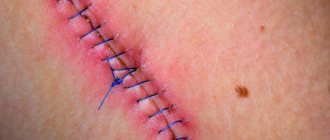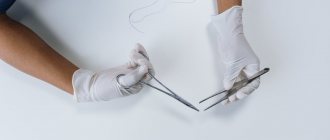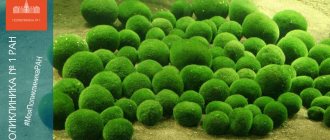home
/
Articles
/
Consequences of late suture removal
Suturing is a surgical intervention after or instead of surgery, which serves to heal the tissue. Application is resorted to only in cases where the wound is extensive and cannot heal on its own. At the moment, there is a large amount of not only medical materials for this procedure, but also many execution techniques. The technique and materials are selected solely on the basis of the nature of the wound, location and experience of the surgeon, and neither the application nor the removal process is discussed with the patient.
Now such an intervention does not take more than 15 minutes, but recovery can last for weeks. Even if you need to have stitches removed, it is not necessary to stay in the hospital, as it is now quite common to remove stitches at home with the help of specialists.
What types of seams are there and what is their difference?
Depending on the degree of tissue damage, there are many types of sutures and methods of applying them. But they are all divided into external and internal.
External sutures or, as they are also called, superficial sutures: applied to the skin or superficial mucous membranes in one layer, the threads are removed immediately after the tissue has grown together.
Internal seams (plunging) remain deep in the fabric. Most often, absorbable sutures or sutures are used that can later exit through the genitals.
Departure is paid separately - from 550 rubles
Request a call
Call:
+7 (499) 455-08-05
Regardless of what type of seam is used, there are the following types:
- skin;
- muscular;
- tendon;
- capillary;
- intestinal.
The type of suture is selected depending on the depth of the wound and its location. Another important aspect is the patient’s age, since older people have a very low ability to regenerate tissue, which is why submerged sutures are most often used on them.
Possible reasons for a wet seam
If you observe the postoperative wound, for the first few days it will be a little damp and even hot. The first few hours the suture may bleed. Then the blood coagulates and dries, but shiny droplets are still visible on the wound - transudate. This is a natural transparent moisture secreted by the serous membranes as a result of fluid filtration by blood vessels.
Over time, the serous fluid no longer flows so abundantly, because the condition of the tissue returns to normal. Otherwise, the amount of transudate may increase. This indicates the beginning of an inflammatory process, the causes of which are different.
- Incorrectly installed or removed drainage system too early.
- Low quality suture and dressing materials.
- Dressing under non-sterile conditions.
- The intervals between dressings are too long.
- Incorrectly chosen treatment tactics with antibiotics and local remedies.
- Reduced immunity of the patient.
The abundant secretion of serous fluid is a kind of protective reaction of tissues to the inflammatory reaction. But it turns out that the situation is only getting worse: a humid environment leads to the fact that the suture festers after the operation, i.e. inflammation develops more rapidly. Transudate is transformed into exudate - a liquid of inflammatory nature.
In addition to serous fluid, transparent or whitish ichor may ooze from the postoperative suture - this is lymph that is released from small capillaries. With the ichor flowing out of the wound, toxins and microbes are “washed out”, so this process is natural for the first few days. If it does not stop, then bloody discharge can also cause the wound to get wet and not heal for a long time.
Why and in what cases are stitches applied?
A large cut or wound, whether in an adult or a child, may require stitches. This is done for several reasons:
- for rapid healing of the skin;
- to avoid infection in an open wound;
- for an aesthetic appearance (when a wound has formed on the face).
Only a doctor can determine whether a wound can heal on its own. In doing so, he is guided by the following principles:
- Depth of the wound. Are subcutaneous layers or fatty tissue visible in the wound?
- Disclosure. Is it possible to gently close the edges of the wound?
- Bleeding from the wound. How heavy is the bleeding and can it be stopped?
- Location of the wound. If the wound is on the face, joints, bends of the limbs, or near (inside) the genitals.
- Method of obtaining a wound.
- The presence of a foreign object in the wound.
If the wound is not that serious, then doctors simply apply a bandage and write recommendations for treatment.
Technique for applying postoperative sutures
Suturing is the final chord that completes the operation and leaves behind the entire journey of saving the patient’s life. Sutures can be continuous or interrupted. The choice depends on the location of application.
Order suture removal at home
Promotion
Included in the price:
- Antiseptic treatment
- Removing suture material (suture removal)
- Secondary treatment with antiseptic
- Applying healing ointment
- Applying a bandage
- Necessary materials and preparations
More details about the service
A continuous suture is placed on the abdominal cavity with one thread if there is no separation of the edges. There are several types of continuous seam, each of which has its own technique:
- Furrier. The first suture is placed with a knot near the corner of the wound. Subsequent ones are at the same distance from the edges of the wound.
- Purse string. Applied to temporarily close natural openings in the skin.
Intermittent or knotted sutures are stronger; after they are applied, several knots can be removed to administer medications or wash the wound. There are:
- simple;
- loop-shaped;
- suture with the formation of a skin fold;
- situational.
Despite the wide variety of interrupted sutures, they are applied using the same technology. It is necessary to have several threads in the needle from 15 to 25 cm. The stitches are placed 1.5 cm apart, after each stitch you need to tie a knot.
What affects the time for suture removal?
The main indicator for removing a suture is wound healing. If the sutures are removed too early, the tissues may separate again, resulting in the need for repeated intervention or an unsightly scar that will then have to be removed. If the suture is removed too late, it can cause suppuration or inflammation of the tissue. It is believed that the optimal period for removal is 10 days after application, but the period may vary, depending on the type of operation:
- amputation of limbs - from 12 days to 2 weeks;
- abdominal surgery – up to 1 week;
- Caesarean section - on the 10th day;
- eye surgery – from 6 to 8 days;
- Chest surgery - 2 weeks.
But a specialist can determine whether to remove the stitches or not, based on the patient’s current condition. If it is necessary to hold the suture for a long time, daily treatment of the wound will be required to ensure that the wound does not become inflamed.
In addition, there are several types of postoperative sutures, which also have their own removal times. These include:
- Primary suture - it is applied immediately after surgery. The duration of removal depends on the operation and the current condition of the patient.
- Secondary - applied in case of consumption of the primary seam. It happens:
- early - 1-2 weeks after surgery;
- late - within a month after surgery.
It is important to remember that only a specialist can remove postoperative sutures.
Departure is paid separately - from 550 rubles
Request a call
Call:
+7 (499) 455-08-05
How to understand that complications have arisen after suturing?
Alarming symptoms after removing the “eight” are as follows:
- heavy bleeding that lasts more than a day;
- severe pain, throbbing pain that prevents you from sleeping or leading a normal life;
- very large swelling;
- redness in the intervention area;
- blood in saliva in the first three days after the intervention;
- elevated body temperature.
In all these cases, you must consult your doctor. It is possible that stitches will have to be stitched again to avoid complications.
Remember that removing teeth does not hurt, and removing stitches does not hurt either! The main thing is that this work is performed by a professional.
What thread are used to stitch the stitches?
Now there are quite a few types of threads that surgeons use; they can be classified both by brand and by characteristics. There are these types of threads:
- Absorbable. Able to be independently excreted from the body, incapable of rejection. These types of threads are used if the tissue is able to grow together quickly.
- Non-absorbable. Used for stitching tissues of internal organs or if long-term (permanent) stitching of tissues is necessary.
Absorbable threads are created from materials such as:
- nylon;
- polypropylene;
- catgut;
- lavsan.
When using this type of thread, it is necessary to accurately determine the rate of tissue fusion, since if the thread is removed from the body earlier than necessary, this can cause a number of problems.
Non-absorbable threads consist of the following materials:
- cotton;
- linen;
- silk.
This type of thread has a number of disadvantages. The most important thing is the ability to form microbes in tissue. When choosing, the doctor is guided not only by the purpose of the thread, but also by his own experience, and the patient’s preferences are not taken into account.
How long does it take for threads to dissolve after surgery?
Absorbable threads are used both in surgical operations on the face and in deep tissue layers, and are also used in organ transplants. The main function is to maintain tissues in a stable state until they grow together.
The main factors due to which material can be excreted from the body include:
- chemical reactions of the body when interacting with protein;
- contact with water in the body.
The rate of removal of threads from the body is influenced by the material from which it was created:
- Catgut begins to dissolve after one month, and is completely eliminated from the body after 4 months.
- Lavsan dissolves within 12-13 days, but dissolution may take 1-1.5 months. Most often this material is used in cosmetology.
- Vicryl begins to be eliminated from the body after 2-3 months.
In this case, it is necessary to follow all the rules for wound treatment, since the healing process can not only be delayed, but also cause inflammation or suppuration.
How to avoid getting the seam wet
Preventing the postoperative suture from getting wet is easier than treating a festering wound later. Therefore, patients must take proper care of their sutures. The rules of care are elementary and logical, but for some reason some people still neglect them.
- Change the bandage according to the regimen prescribed by the doctor. Minimum – once a day. If bandages quickly become wet and leak, you should increase the frequency of dressings.
- Changing the dressing should be done with clean hands and without unauthorized persons or animals in the room.
- All dressings (bandages, plasters, cotton wool) must be sterile.
- The seam should not be subjected to mechanical stress: friction against clothing, scratching, picking.
- Do not wet postoperative wounds until they are completely healed.
- If there is any suspicion of pathology (the wound is oozing, the suture has changed color, has festered, become inflamed), you should consult a doctor.
A suture that gets wet after surgery is not only an unpleasant problem that spoils bed linen and clothing, but also a risk of complications in the form of ulcers and necrosis. This also extends the healing time and quality of the suture, which as a result can turn into an unsightly colloidal scar. Therefore, you need to properly care for postoperative wounds and consult a doctor on time.
When should stitches be removed?
The main indicator for removing stitches is wound healing. Factors such as:
- presence of complications;
- patient's age;
- Current state;
- nature of the surgical intervention.
The location of the seam plays a special role; depending on it, the timing of thread removal is set:
- areas of the body with active blood supply - 5-6 days after application;
- shins, feet, arms, knees - approximately on day 10-12, since in such areas there is a slower recovery rate;
- infected wound - the sutures are removed the next day, as treatment and openness are necessary for speedy healing;
- clean wound - a week after application.
Only a surgeon can determine whether removal is necessary at the moment or not during an examination. In addition, for elderly people, sutures are removed no earlier than after 2 weeks, since they have a very low ability to regenerate.
Why do you need stitches after wisdom tooth removal?
Removing the “eight” is a surgical procedure that involves dissecting the tissue in the area of the “wise” tooth. After the tooth is extracted, the gum must be sutured so that it heals without complications. A classic example is when, after suturing, a person is scheduled for a follow-up visit to the dentist. At this stage, it is important to evaluate the process of tissue regeneration and make sure that there are no complications after wisdom tooth removal.
When else do you need stitches? For example, when a dental operation needs to be performed urgently, the dentist does not have the opportunity or time to perform blood clotting tests on the patient (a common picture during dental operations after injuries). In this case, the stitches perform the task of preventing bleeding.
Suture removal technique
Following the correct algorithm for removing sutures and maintaining sanitary conditions allows you not only to avoid infection of the wound, but also to speed up healing. Specialists explain the procedure to the patient before performing it and place him on the couch. The procedure has the following algorithm:
- Removing the protective bandage.
- Inspect the wound and determine the number of stitches to remove.
- Treating the wound with an antiseptic. It must be carried out 2 times to prevent infection, near the wound and inside.
- The suture knot is grabbed with tweezers and lifted.
- The thread that appears after pulling is cut.
- The suture is pulled back with tweezers and the knot is removed.
- Checking the integrity of the skin.
- Treating the wound with an antiseptic.
- The area is covered with a sterile napkin and then fixed with either a bandage or adhesive tape.
This procedure is performed in a hospital, but it is now quite common for postoperative sutures to be removed at home by a specialist.











